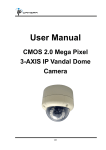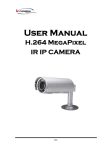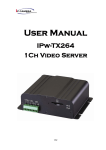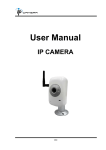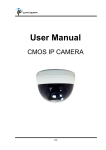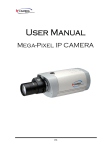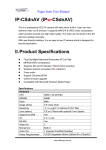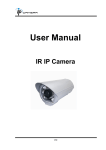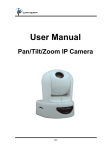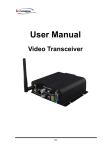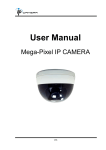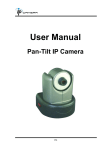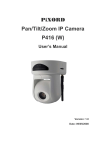Download 1NAG_User Manual_Eng_V1.1_101231 1761KB Feb 14 2012
Transcript
User Manual 3-AXIS IP Dome Camera 1/41 WARINGS TO REDUCE THE RISK OF FIRE OR ELECTRIC SHOCK, DO NOT EXPOSE THIS PRODUCT TO RAIN OR MISTURE. DO NOT INSERT ANY METALLIC OBJECT THROUGH VENTILATION GRILLS. CAUTION CAUTION RISK OF ELECTRIC SHOCK DO NOT OPEN CAUTION:TO REDUCE THE RISK OF ELECTRIC SHOCK. DO NOT REMOVE COVER (OR BACK). NO USER-SERVICEABLE PARTS INSIDE. REFER SERVICING TO QUALIFIED SERVICE PERSONNEL. COPYRIGHT THE TRADEMARKS MENTIONED IN THE MANUAL ARE LEGALLY REGISTERED TO THEIR RESPECTIVE COMPANIES. 2/41 Content I. PREFACE ....................................................................................................................................... 4 II. PRODUCT SPECIFICATIONS ....................................................................................................... 4 III. PRODUCT INSTALLATION ........................................................................................................... 6 A. MONITOR SETTING..................................................................................................................................... 6 B. HARDWARE INSTALLATION AND I/O PIN ASSIGNMENT ............................................................................... 7 C. IP ASSIGNMENT ....................................................................................................................................... 12 D. INSTALL ACTIVEX CONTROL: ................................................................................................................... 14 IV. LIVE VIDEO .................................................................................................................................. 16 V. CONFIGURATION ........................................................................................................................ 18 A. SYSTEM ................................................................................................................................................... 19 B. NETWORK ................................................................................................................................................ 23 C. A/V SETTING ........................................................................................................................................... 27 D. EVENT LIST .............................................................................................................................................. 33 VI. NETWORK CONFIGURATION .................................................................................................... 39 VII. FACTORY DEFAULT ................................................................................................................... 41 VIII. PACKAGE CONTENTS ............................................................................................................... 41 APPENDIX I .......................................................................................................................................... 41 V1.1_101231 3/41 I. Preface 3-Axis IP Dome is a professional CCD IP Dome. It has built-in web server which enables user to view real-time video via IE browser. It also supports simultaneously H.264/JPEG/ MPEG4 (3GPP Only) video compression with CCD Sensor which provides smooth and high video quality. The video can be stored in the SD card, and can be playback remotely. 3-Axis IP Dome is an easy-to-use IP Camera which is designed for security application. II. Product Specifications z z z z z z z z z z z z z D-WDR system Next Generation 3D DNR Sense-Up function Power over Ethernet available 3-Axis Gimbal Adjustments IR LED Built in 12M available Mechanism IR Cut Filter Available H.264/ JPEG/ MPEG4 (3GPP only) compression SD card backup 2-way audio Support Cell Phone/PDA/3GPP SDK for Software Integration Free Bundle 36 ch recording software Specifications Hardware CPU ARM 9 ,32 bit RISC RAM 256MB Flash 16MB Image sensor 1/3” CCD Sensor Lens Type Vari-focal 3.7~12mm Lens 4/41 ICR Mechanism IR cut Filter(Optional) LED Built-in 18 IR LED (optional) IR Distance-12M (Optional) I/O 1 in/ 1 Relay Out Video Out x1 Audio In x1 Audio Out x1 Power over Ethernet Yes (Optional) Power Consumption DC 12V 470mA 3-Axis Gimbal Adjustments Angle Pan: 172∘ Tilt 30∘~90∘ Rotation 180∘ Dimensions ∮132 * H 108.4 Network Ethernet 10/ 100 Base-T Network Protocol HTTP, TCP/ IP, UDP, SMTP, FTP, PPPoE, DHCP, DDNS, NTP, UPnP, 3GPP System Video Resolution NTSC - 720x480, 704x480,352x240, 176x144 PAL – 720x576, 704x576, 352x288, 176x144 Video Adjust Brightness, Contrast, Saturation, Hue, Sharpness, AES, Manual shutter, IRIS Level, BLC, Day and night, night mode, 3D DNR, WDR, Flip and Mirror Triple Streaming Yes Image Snapshot Yes Full Screen Monitoring Yes Privacy Mask Yes, 3 different areas Compression Format H.264/ JPEG/ MPEG4 (3GPP only) Video Bitrates Adjust CBR, VBR Motion Detection Yes, 3 different areas Triggered Action Mail, FTP, Save to SD card, Relay Pre/ Post Alarm Yes, configurable Security Password protection 5/41 Firmware Upgrade HTTP mode, can be upgraded remotely Simultaneous Connection Up to 10 Audio Yes, 2-way SD card management Recording Trigger Motion Detection, IP check, Network break down (wire only),schedule, alarm Video Format AVI, JPEG Video Playback Yes Delete Files Yes Web browsing requirement OS Windows 2000, XP, 2003, Microsoft IE 6.0 or above Hardware Suggested Intel Dual Core 1.66G,RAM: 1024MB, Graphic card: 128MB Minimum Intel-C 2.8G, RAM: 512MB, Graphic card: 64MB *SPECIFICATIONS ARE SUBJECT TO CHANGE WITHOUT NOTICE. III. Product Installation A. Monitor Setting i. Right-Click on the desktop. Select “ Properties” ii. Change color quality to highest (32bit). 6/41 B. Hardware Installation and I/O Pin Assignment i. Connect a power adapter and IP Camera to PC or local network 7/41 ii. 3-Axis Gimbal Adjustments 1 ○ Pan: 172° 2 ○ 3 ○ Tilt: 30°~90° Rotation: 180° Once the users open the case, the gimbal adjustment offers the convenience method to install on the wall. The pan, tilt, and rotation are provided in this model. The users can adjust the gimbal with Pan 172 degree, tilt 30~90 degree, and rotation 180 degree respectively. iii. I/O Control Instruction I/O terminal connector – used in application, for e.g., motion detection, event triggering, alarm notifications. It provides the interface to: 1 Digital Input (GND+Alarm) – An alarm input for connecting devices that can toggle between an open and closed circuit, for example: PIRs, door/window contacts, glass break detectors, etc. When a signal is received the state changes and the input becomes active. Relay output (COM +N.O.) / (COM+N.C.) – An output to Relay switch, for example: LEDs, Sirens, etc iv. Digital Input Alarm Input 1. GND (Ground) : Initial state is LOW 2. Alarm : Max. 50mA, DC 3.3V 8/41 Relay Output 1. N.C. (Normally Close): Max. 1A, 24VDC or 0.5A, 125VAC 2. COM: (Common) 3. N.O. (Normally Open): Max. 1A, 24VDC or 0.5A, 125VAC ALARM IN RELAY OUT v. Relay 1. Digital Input connection Door/Window Contacts GND ALARM N.C. COM N.O. 9/41 2. Relay Output Connection GND ALARM N.C. COM N.O. Or GND ALARM N.C. COM N.O. 10/41 v. PoE ( Power Over Ethernet)(Optional) 802.3af, 15.4W PoE Switch is recommended Power over Ethernet (PoE) is a technology that integrates power into a standard LAN infrastructure. It enables power to be provided to the network device, such as an IP phone or a network camera, using the same cable as that used for network connection. It eliminates the need for power outlets at the camera locations and enables easier application of uninterruptible power supplies (UPS) to ensure 24 hours a day, 7 days a week operation. Ethernet PoE IP Camera PoE Switch Ethernet Cable Ethernet Cable PoE IP Camera 11/41 C. IP Assignment i. ii. iii. iv. v. Use the software, “IP Installer” to assign the IP address of IP CAMERA. The software is in the attached software CD. IP installer supports two languages a. IPInstallerCht.exe:Chinese version b. IPInstallerEng.exe:English version There are 3 kinds of IP configuration. a. Fixed IP (Public IP or Virtual IP) b. DHCP (Dynamic IP) c. Dial-up (PPPoE) Execute IP Installer For Windows XP SP2 user, it may popup the following message box. Please click “Unblock”. vi. IP Installer configuration: vii. IP Installer will search all IP Cameras connected on Lan. The user can click “Search Device” to search again. 12/41 viii. Click one of the IP Camera listed on the left side. The network configuration of this IP camera will show on the right side. You may change the “name” of the IP Camera to your preference (eg: Office, warehouse). Change the parameter and click “Submit” then click “OK”. It will apply the change and reboot the Device. ix. Please make sure the subnet of PC IP address and IP CAM IP address are the same. The same Subnet: IP CAM IP address: 192.168.1.200 PC IP address: 192.168.1.100 Different Subnets: IP CAM IP address: 192.168.2.200 PC IP address: 192.168.1.100 To Change PC IP address: Control PanelÆNetwork ConnectionsÆLocal Area PropertiesÆInternet Protocol (TCP/IP) ÆProperties Connection Please make sure your IP Camera and PC have the same Subnet. If not, please change IP Camera subnet or PC IP subnet accordingly. x. A quick way to access remote monitoring is to left-click the mouse twice on a selected IP Camera listed on “Device list” of IP Installer. An IE browser will be opened. 13/41 xi. D. Then, please key in the default “user name: admin” and “password: admin”. Install ActiveX control: For the first time to view the camera video via IE, it will ask you to install the ActiveX component. If the installation failed, please check the security setting for the IE browser. i. IE Æ Tools Æ Internet Options… Æ Security Tab Æ Custom Level… Æ Security Settings Æ Download unsigned ActiveX controlsÆ Select “Enable” or Prompt. ii. IE Æ Tools Æ Internet Options… Æ Security Tab Æ Custom Level… ÆInitialize and script ActiveX controls not marked as safe Æ Select “Enable” or Prompt. 14/41 1 2 3 4 5 When popup the following dialogue box, click “Yes”. 15/41 IV. Live Video Start a IE browser, type the IP address of the IP camera in the address field. It will show the following dialogue box. Key-in the user name and password. The default user name and password are “admin” and “admin”. When connect to the IP CAMERA。The following program interface shows. 2 1 3 4 5 6 7 16/41 1. :Get into the administration page 2. :Video Snapshot 3. 4. Show system time, video resolution, and video refreshing rate Select video streaming source (When streaming 2 setting in『Video Setting』 is closed, this function will not display) 5. IP Camera supports 2-way audio. Click the “Chatting” check box. Then you can use microphone which connects to the PC to talk to server side, which is IP Camera side 6. Shows how many people connect to this IP camera 7. Control the relay which is connected to this camera. Double-click the video, it will change to full screen mode. Press “Esc” or double-click the video again, it will change back to normal mode. Right-Click the mouse on the video, it will show a pop-up menu. 1. Snapshot:Save a JPEG picture 2. Record Start:Record the video in the local PC. It will ask you where to save the 3. 4. video. To stop recording, right-click the mouse again. Select “Record Stop”. The video format is AVI. Use Microsoft Media Player to play the recorded file. Mute:Turn of the audio. Click again to turn on it. Full Screen:Full-screen mode. 5. ZOOM: Enable zoom-in and zoom-out functions. Select “Enable digital zoom” option first within the pop-up dialogue box and then drag and drop the bar to adjust the zoom factors. 17/41 V. Configuration Click to get into the administration page. Click video page. 18/41 to go back to the live A.System i、 System Information a. Server Information: Set up the camera name, select language, and set up the camera time. 1. Server Name:This is the Camera name. This name will show 2. on the IP Installer. Select language:There are English, Traditional Chinese, and Simplified Chinese to select. When change, it will show the following dialogue box for the confirmation of changing language. b. OSD Setting: Select a position where date & time stamp / text showing on screen. Moreover, click Text Edit can entry to adjust the OSD contents which is including Size and Alpha of text. Finally, click Upgrade button to reserve the setting. c. Server time setting:Select options to set up time - “NTP”, “Synchronize with PC’s time”, “Manual”, “The date and time remain the same”. 19/41 ii、 User Management IP CAMERA supports three different users, administrator, general user, and anonymous user. a. b. Anonymous User Login: Yes:Allow anonymous login No:Need user name & password to access this IP camera Add user: c. Type the user name and password, then click “Add/Set”. Click “edit” or “delete” to modify the user. 20/41 21/41 iii、 System update: a. b. To update the firmware online, click “Browse…” to select the firmware. Then click “Upgrade” to proceed. Reboot system:re-start the IP camera c. d. Factory default:delete all the settings in this IP camera. Setting Management:User may download the current setting to PC, or upgrade from previous saved setting. 1. Setting download: Right-click the mouse button on Setting Download Æ Select “Save AS…” to save current IP CAM setting in PC Æ Select saving directory Æ Save 2. Upgrade from previous setting Browse Æ search previous setting Æ open Æ upgrade Æ Setting update confirm Æ click index.html. to return to main page 22/41 B.Network i、 IP Setting IP Camera supports DHCP and static IP. a. DHCP:Using DHCP, IP Camera will get all the network parameters b. automatically. Static IP:Please type in IP address, subnet mask, gateway, and c. DNS manually. Port Assignment: user may need to assign different port to avoid conflict when setting up IP assignment. 1. Web Page Port: setup web page connecting port and video transmitting port (Default: 80) 2. RTSP Port: setup port for RTSP transmitting (Default: 554) 3. RTP Start and End Port: in RTSP mode, you may use TCP and UDP for connecting. TCP connection uses RTSP Port (554). UDP connection uses RTP Start and End Port. 23/41 d. UPnP This IP camera supports UPnP, If this service is enabled on your computer, the camera will automatically be detected and a new icon will be added to “My Network Places.” Note: UPnP must be enabled on your computer. Please follow the procedure to activate UPnP 1. open the Control Panel from the Start Menu 2. select Add/Remove Programs 3. Select Add/Remove Windows Components and open Networking Services section 4. Click Details and select UPnP to setup the service 5. The IP device icon will be added to “MY Network Places” 6. User may double click the IP device icon to access IE browser ii、 PPPoE: Select “Enabled” to use PPPoE. Key-in Username and password for the ADSL connection. Send mail after dialed:When connect to the internet, it will send a mail to a specific mail account. For the mail setting, please refer to “Mail and FTP” settings. iii、 DDNS: It supports DDNS (Dynamic DNS) service. a. DynDNS: 24/41 1. 2. 3. 4. 5. Enable this service Key-in the DynDNS server name, user name, and password. Set up the IP Schedule update refreshing rate. Click “Apply” If setting up IP schedule update too frequently, the IP may be blocked. In general, schedule update every day (1440 minutes) is recommended. 25/41 b. c. Camddns service: 1. Please enable this service 2. Key-in user name. 3. IP Schedule update is default at 5 minutes 4. Click “Apply”. DDNS Status 1. Updating:Information update 2. Idle:Stop service 3. 4. DDNS registration successful, can now log by http://<username>.ddns.camddns.com:Register successfully. Update Failed, the name is already registered:The user name 5. has already been used. Please change it. Update Failed, please check your internet connection:Network 6. connection failed. Update Failed, please check the account information you provide:The server, user name, and password may be wrong. 26/41 C. A/V Setting i、 Image Setting For the security purpose, there are three areas can be setup for privacy mask. Click Area button first and pull a area on the above image. Finally, click Save button to reserve the setting. Adjust “Brightness”, “Contrast”, “Hue”, “Saturation” to get clear video. Moreover, IP CAMERA supports “Back Light Compensation”, “Night Mode” and “Video Orientation”. Among CCD Setting, user can adjust “Electronic Shutter”, “IRIS Level” with drop down list and other settings such as BLC Mode, Day & Night, Night Mode, 3D DNR, WDR Mode and Video Orientation. 27/41 ii、 Video Setting User may select 2 streaming output simultaneously: Streaming 1 Setting: Basic mode and Advanced mode Streaming 2 Setting: Basic mode, Advanced mode, and 3GPP mode (Max Video Frame Rate for both streaming combined is 30 FPS) a. Streaming 1 Basic Mode: 1. Resolution: 2. There are 4 resolutions can be chosen. D1 – 720 x 480 4CIF – 704 x 480 CIF – 352 x 240 QCIF – 176 x 144 Quality: 3. 4. There are 5 levels to adjust: Best/ High/ Standard/ Medium/ Low The higher the quality is, the bigger the file size is. Also not good for internet transmitting Video Frame Rate:The video refreshing rate per second. Video Format:H.264 or JPEG 5. RTSP Path: RTSP output name 28/41 b. Streaming 1 Advanced Mode: 1. 2. Resolution: There are 4 resolutions can be chosen. D1 – 720 x 480 4CIF – 704 x 480 CIF – 352 x 240 QCIF – 176 x 144 Bitrate Control Mode There are CBR﹝Constant Bit Rate﹞ and VBR﹝Variable Bit Rate﹞to use. CBR:32Kbps~4Mbps (the higher the CBR is, the better the video quality is) VBR:1(Low)~10(High) – Compression rate, the higher the 5. compression rate, the lower the picture quality is; vise versa. The balance between VBR and network bandwidth will affect picture quality. Please carefully select the VBR rate to avoid picture breaking up or lagging. Video Frame Rate The video refreshing rate per second. NTSC: Max 30 frames/second PAL: Max 25 frames/second GOP Size It means "Group of Pictures". The higher the GOP is, the better the quality is. Video Format:H.264 or JPEG 6. RTSP Path: RTSP output connecting route 3. 4. 29/41 c. d. Streaming 2 Basic Mode: 1. Resolution: 2. There are 4 resolutions can be chosen. D1 – 720 x 480 4CIF – 704 x 480 CIF – 352 x 240 QCIF – 176 x 144 Quality: 3. 4. There are 5 levels to adjust: Best/ High/ Standard/ Medium/ Low The higher the quality is, the bigger the file size is. Also not good for internet transmitting Video Frame Rate:The video refreshing rate per second. Video Format:H.264 or JPEG 5. RTSP Path: RTSP output connecting route Streaming 2 Advanced Mode: 1. Resolution: 2. There are 4 resolutions can be chosen. D1 – 720 x 480 4CIF – 704 x 480 CIF – 352 x 240 QCIF – 176 x 144 Quality: 30/41 e. 3. There are 5 levels to adjust: Best/ High/ Standard/ Medium/ Low The higher the quality is, the bigger the file size is. Also not good for internet transmitting Video Frame Rate: 4. The video refreshing rate per second. Video Format:H.264 or JPEG 5. RTSP Path: RTSP output name 3GPP Streaming mode: 3GPP mode suggested setting: 176x144 resolution, 5FPS, MPEG4 format 1. 2. Enable or Disable 3GPP Streaming 3GPP: 3GPP output name 31/41 iii、 Audio: IP CAMERA supports 2-way audio. User can send audio from IP Camera Built-in mic to remote PC; User can also send audio from remote PC to IP Camera’s external speaker. a. Audio from IP camera built-in mic to local PC: select “Enable” to start this function. b. Audio from local PC to IP Camera: Check “chatting” in the browsing page. The Audio will not be smooth when enable SD card recording function simultaneously. 32/41 D.Event List IP CAMERA provides multiple event settings. i、 Event Setting a. b. Motion Detection: IP CAMERA allows 3 areas motion detection. When motion is triggered, it can send the video to some specific mail addresses, transmit the video to remote ftp server, trigger the relay, and save video to local SD card. To set up the motion area, click “Area Setting”. Using mouse to drag and draw the area. The same operation for area 2 and 3. Record File Setting: IP CAMERA allows 3 different types of recording file to change its record size. 33/41 c. When motion/alarm is triggered, there are 3 different types of record mode. 1. AVI File (With Record File Setting ) 2. Multi-JPEG (With Record File Setting), only with JPEG compression format. 3. Single JPEG (Single File with Interval Setting) Record Time Setting: Pre Alarm and Post Alarm setups for video start and end time when motion detected, I/O, or other devices got triggered. Note: Pre/Post Alarm record time is base on record time setting and IP Cam built-in Ram memory. Limited by IP Cam built-in Ram Memory, When information is too much or video quality set too high, it will cause recording frame drop or decrease on post alarm recording time. d. e. Network Dis-connected: When the network is down, it will save the video to local SD card. This function is only enabled in wire connection. Network IP check When the connection is down, it records the video to SD card. Make sure the video recording is continuous. To use this function, key in the IP address of the PC which has recording software installed. Enable the function of “Save to SD card”, then click “Apply”. The interval of two video files on SD card is fixed with 30 seconds. ii、 Schedule a. Schedule: After complete the schedule setup, the camera data will be recorded according to the schedule setup. b. Snapshot: After enable the snapshot function, user can select the storage position of snapshot file, the interval time of snapshot and the reserved file name of snapshot. 34/41 iii、 I/O Setting IP CAMERA supports 1 input/ 1 output. When input is triggered, it can send the video to some specific mail addresses, transmit the video to remote ftp server, trigger the relay, and save video to local SD card. CATUTION!! Please connect to propriety relay box to reduce the risk of electric shock & damaged. Alarm Input Setting By GPIO I/O port input that provide related action while I/O input triggered. GPIO Output Setting By GPIO I/O port output that provide OnOff Switch, Slide Switch & Pan/Tilt 35/41 Module for using with relay box. GPIO pin define please refer to the part of Front / Back plane & I/O port pin assignment GPIO 0 GPIO 1 GPIO 2 GPIO 3 ALARM INPUT Normal: 3.3V (The voltage differential from GPIO pin & GND) Active: 0V (GPIO 0 & GPIO1 link to PIN2 GND) ALARM OUTPUT Normal: 3.3V (The voltage differential from GPIO pin & GND) Active: 0V (GPIO 0 & GPIO1 link to PIN2 GND) GPIO INSTALLATION EXAMPLE 1 Trigger a normal off (Normal Open) alarm siren on when event/motion occur at COM: 9PIN D-SUB WEB SERVER / IP CAMERA GPIO INSTALLATION EXAMPLE 2 Trigger the normal on (Normal Close) indoor illumination off when event / motion occur at COM: 9PIN D-SUB WEB SERVER / IP CAMERA 36/41 iv、 Mail & FTP To send out the video via mail of ftp, please set up the configuration first. v、 Log List Sort by System Logs, Motion Detection Logs and I/O Logs. In addition, System Logs and I/O Logs won’t lose data due to power failure. vi、 SD card 37/41 Please Insert SD card before use it. Make sure pushing SD card into the slot completely. Note:The use of the SD card will affect the operation of the IP CAMERA slightly, such as affecting the frame rate of the video. Playback: 1. It will show the capacity of the SD card. Click the date listed on this page. It will show the list of the video. 2. The video format is AVI. Click the video to start Microsoft Media Player to play it. To delete the video, check it, then click Del. When the SD card is full, it will remove the oldest video automatically. 3. 38/41 VI. Network Configuration i、 Configuration 1: a. b. Internet Access:ADSL or Cable Modem IP address:One real IP or one dynamic IP c. d. Only IP CAMERA connects to the internet For fixed real IP, set up the IP into IP CAMERA. For dynamic IP, start PPPoE. ii、 Configuration 2: a. b. Internet Access:ADSL or Cable Modem IP address:More than one real IP or one dynamic IP c. d. IP CAMERA and PC connect to the internet Device needed:Switch Hub e. For fixed real IP, set up the IP into IP CAMERA and PC. For dynamic IP, start PPPoE. 39/41 iii、 Configuration 3: a. b. Internet Access:ADSL or Cable Modem IP address:one real IP or one dynamic IP c. d. IP CAMERA and PC connect to the internet Device needed:IP sharing e. Use virtual IP, set up port forwarding in IP sharing. 40/41 VII. Factory Default i、 To recover the default IP address and password, please follow the following steps. ii、 Remove power, and press and hold the button in the back of IP CAMERA. Factory Default iii、 Power on the camera. Don’t release the button during the system booting. iv、 It will take around 30 seconds to boot the camera. v、 Release the button when camera finishes proceed. vi、 Re-login the camera using the default IP (http://192.168.1.200), and user name (admin), password (admin). VIII. Package contents i、 IP CAMERA Network Camera ii、 Adaptor iii、 Ethernet Cable iv、 CD title (User manual, IP installation Utility) Appendix I SD Card Recommended: SanDisk 128M SanDisk 256M SanDisk 512M SanDisk 1G SanDisk 2G SanDisk 4G SanDisk 8GB SanDisk 16GB SanDisk 32GB Transcend 4GB Transcend 8GB Transcend 16GB Transcend 32GB 41/41









































